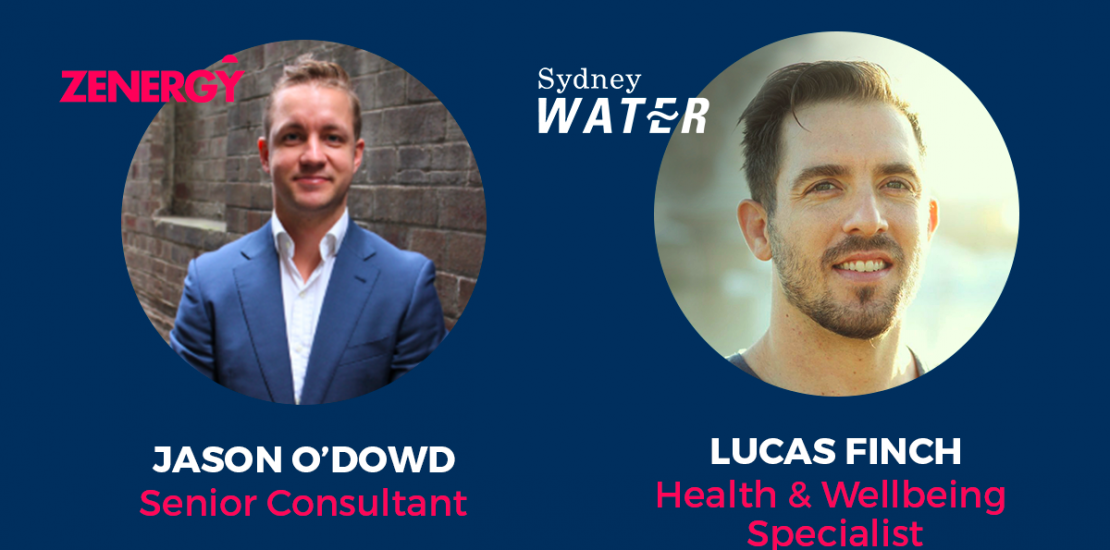An interview with Lucas Finch – Sydney Water
An interview with Lucas Finch – Sydney Water

An interview with Lucas Finch – Sydney Water, by Jason O’Dowd
Lucas creates outcomes for companies who wish to see their employees thrive while improving the bottom line by developing organisational strategies that move workplace wellbeing beyond being centred around fruit bowls and yoga classes and towards an integrated way of doing business. Specialising in understanding organisational needs, distilling the best parts of evidence-based approaches, and a knack for helping these ideas come alive through engaging groups and changing cultures.
You are a champion for employee wellbeing, which is presumably one of the more important things for a company to focus on. Why do you think it matters so much?
After years partnering with people to develop their wellbeing, I really appreciate how in addition to getting exercise in, eating good meals, and getting enough sleep, our wellbeing is also a product of the systems we are embedded within.
Our family, relationships, community, and our workplaces- where we spend so many of the waking hours of our lives- play a significant role in contributing to our health and wellbeing
What does Wellbeing in an organisational capacity mean to you?
It is an exciting time as many organisations are moving beyond gestures of fruit bowls and yoga classes towards an integrated approach where wellbeing is sewn into the fabric of how they do business.
Organisations who have integrated wellbeing into their organisation have made a visible position that clearly defines what health & wellbeing is, and how the organisation is committed to protecting and promoting wellbeing through their policies, programs, and procedures.
Organisations who are leading the way have integrated wellbeing into the way they design and carry out work. They are doing this by creating a shared understanding of the relevant factors in our work that influence our core health and wellbeing needs and influencing them. These can be physical and environmental factors, but are also things like role autonomy, role clarity, and how our work helps us meet our social need of relatedness.
Organisations that articulate leadership expectations that includes a standard for leaders to have the capacity for supportive leadership is also important. Leaders who can understand the ‘whole person’, are better able to identify and influence our core human needs.
What we have learned from this disruption regarding promoting and protecting mental health & wellbeing
Some organisations have learnt that their previous strategy of outsourcing psychological wellbeing through distributing EAP flyers is drastically insufficient
.
Organisations who happened to already be on the front foot have learnt the value of having established roles responsible for the protection and promotion of wellbeing, frameworks in place and mechanisms for influencing this area have been far better prepared to be of use to their people during this time
How to thrive during a change in the current working environment.
I think this recent disruption to our working environment has highlighted the importance of employee wellbeing, the critical role of supportive leadership and the importance of being able to identify and influence the factors that influence our health & wellbeing in the workplace.
While this current disruption has hit us all for six, the reality may well be that ‘disruption’ becomes an ever-increasing feature of our lives. Technological disruptions like AI, robotics and automation are coming our way and they are only the visible tip of the iceberg.
The better we can develop literacy in a language that effectively names and is able to influence factors that impact upon our wellbeing, the better we will be positioned as organisations to adapt and thrive to changes that lay ahead of us.
How can employee wellbeing be measured? Are there any good practices in this area?
Where possible use instruments that can refer to the evidence based on which they are developed, and ideally a tool that can objectively benchmark your organisation
While it is a bit of work, look to link individual wellbeing scores to HR metrics. This way you can understand how the wellbeing of your workforce impacts your existing organisational measures.
Finally, measuring organisational climate, specific to health & wellbeing, is valuable. The degree to which your people feel their workplace protects and supports their wellbeing, and that demands for productivity do not continually erode this precious resource, has significant correlates with individual and organisational outcomes.
What in your opinion are the best freely available resources for Mental Health and Wellbeing?
Kindness, the Heads Up Beyond Blue workplace mental health resources, and developing a strategy for promoting and protecting the health & wellbeing of the people in your organisation.
I would like to thank Lucas for his time and considered answers to these very important questions, and I am sure this will provide some great information to the public about workplace Wellness initiatives.
If you are interested in learning more about Zenergy , or if you would like to collaborate in our next Health, Safety and Wellbeing blog please feel free to contact Jason O’Dowd at Jason.ODowd@zenergygroup.com.au






